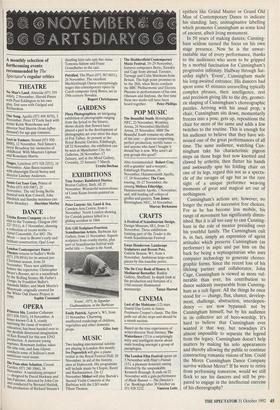Dance
Merce Cunningham Dance Company (Queen Elizabeth Hall)
Cunningham cult
Sophie Constanti
To suggest that the current popularity of the Merce Cunningham Dance Compa- ny might, possibly, have something to do with a predictable consensus of respect for Cunningham because of his age, rather than genuine appreciation of the 73-year- old choreographer's creative output, is to invite accusations of heresy. But these days Cunningham only has to hobble on stage and dabble his way through a few familiar and limited movements — as happened last weekend during a series of 'Events' pre- sented as part of this year's Dance Umbrel- la festival — and he is inevitably received with the worst kind of sentimental venera- tion, emanating from an audience which has put him on a pedestal for all the wrong reasons. Since entering the ranks of senior citizenship, Cunningham has also become a criticism-free zone. We have taken to using
don't know about you, but I could murder a pint of vinyl silk emulsion.' epithets like Grarid Master or Grand Old Man of Contemporary Dance to indicate his standing: lazy, unimaginative labelling which promotes Cunningham as some kind of ancient, albeit living monument.
In 50 years of making dances, Cunning- ham seldom turned the focus on his own stage presence. Now he is the unwar- rantable star of every performance, thanks to the audiences who seem to be gripped by a morbid fascination for Cunningham's progressive infirmity. Halfway through Sat- urday night's 'Event', Cunningham made his long-awaited entrance. His dancers had spent some 45 minutes unravelling typically complex phrases, their intelligence, zest and precision giving life to the dry, geomet- ric shaping of Cunningham's choreographic puzzles. Arriving with his usual prop, a chair, Cunningham sits down, momentarily freezes into a pose, gets up, repositions the chair for more of the same and adds a few twitches to the routine. This is enough for his audience to believe that they have wit- nessed one of the great performances of all time. The same audience, watching Cun- ningham take his characteristic pigeon steps on those huge feet now knotted and clawed by arthritis, then flutter his hands and awkwardly spin his folding chair on one of its legs, regard this not as a specta- cle of the ravages of age but as the rare sight of a unique performer weaving moments of great and magical art out of nothingness. Cunningham's actions are, however, no longer the result of successive free choices. For as he has become less mobile, his range of movement has significantly dimin- ished. But it is all too easy to cast Cunning- ham in the role of mentor presiding over his youthful family. The Cunningham cult is, in fact, simply an expression of ageist attitudes which preserve Cunningham (as performer) in aspic and pat him on the back for being a septuagenarian who uses computer technology to generate choreo- graphic forms. Since the recent loss of his lifelong partner and collaborator, John Cage, Cunningham is viewed as more vul- nerable than ever, his contribution to dance suddenly inseparable from Cunning- ham as a cult figure. All the things he once stood for — change, flux, chance, develop- ment, challenge, abstraction, interdepen- dency — are now bypassed: not by Cunningham himself, but by his audience in its collective act of hero-worship. It's hard to believe that Cunningham ever wanted it that way, but nowadays it's almost impossible to separate the legend from the legacy. Cunningham doesn't help matters by making his solo appearances and thereby allowing the public to continue constructing romantic visions of him. Could the Merce Cunningham Dance Company survive without Merce? If he were to retire from performing tomorrow, would we still flock to see his dancers and still be pre- pared to engage in the intellectual exercise of his choreography?



























































 Previous page
Previous page